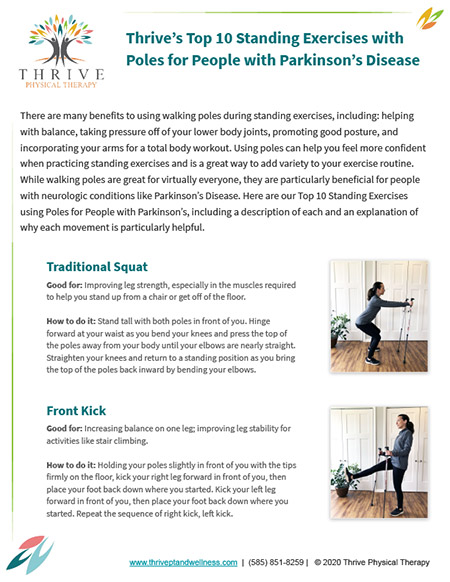
As a physical therapist who offers outpatient physical therapy at home, I am always on the lookout for equipment to help my clients with their fitness and mobility.
The best equipment needs to meet a lot of criteria: it must be portable, effective, able to be used
in a variety of ways, and accessible for my clients to use on a long-term basis. At the very top of my list of favorites that checks all of these boxes (and you probably know this if we’ve worked together) are walking poles!
Buddy’s story
I’ll never forget Buddy (that’s what we’ll call him here), one of my first clients to use walking poles (also known as Nordic or Trekking poles). They made, and continue to make, a profound impact on his life. Buddy is in his 70s and is a person with Parkinson’s disease; he was referred for physical therapy for help with freezing of gait (he felt like his feet were glued to the floor while walking) and frequent falls. The first time he used walking poles was instantly life-changing! He walked all the way to the end of his street and back to his house with virtually no freezing and no stumbling. Buddy held his head up high, and as we walked back into his house, he looked at me with tears in his eyes and said “I haven’t walked that far in years.”

Over the next several weeks we continued his physical therapy, working together on his ability to walk and we continued to use the poles for exercises and for walking. Buddy had a fear of falling when out in public that had been making him limit his activity for quite some time and because of this, he was quite weak and deconditioned. By the time he was ready to graduate physical therapy, his freezing episodes had become infrequent and when they did happen, he was able to overcome them in just a couple seconds; he was using his poles all the time and he could walk around the entire block of his neighborhood, TWICE!! Most importantly, he had returned to doing many of his favorite activities in the community, like his Sunday morning diner breakfast with his group of pals.
Buddy loved that the walking poles made him taller and more confident and that they looked “athletic and cool.” Buddy ended up using the walking poles like an assistive device, in place of a walker or a cane, but for many of my clients the poles are not intended to be an assistive device. Instead they are used as a tool for exercise and for support during more rigorous outdoor walks.
Walking poles are great for everyone, but I especially love them for people with Parkinson’s disease due to their ability to target and improve many common symptoms of PD.
Here’s my top 5 list of why I love poles so much for PWP:
Posture: Properly fitted walking poles are positioned at a height that encourages extension through the spine and counteracts a stooped posture. The spinal extension lengthens the muscles on the front of your body when you activate the muscles on the back of your body; these extensor muscles become stronger and better able to hold you in a taller position throughout the day.
Balance: Many of my clients have postural instability, a hallmark symptom of Parkinson’s disease, which causes people to lose their balance and be at a higher risk for falls. Walking poles provide external support when performing more challenging balance exercises or walking on uneven terrain. The poles give you more confidence and stability, which allows you to progress to more advanced activities.
Coordination: At first, walking poles may feel awkward; you need to coordinate a new sequence of movements, determine where to place the poles, and maintain timing as you step and place each pole on the floor. Keep practicing! Practicing with the poles will refine your coordination and will promote a more symmetrical arm swing, something with which many people with Parkinson’s struggle.
Motor Learning: Learning a new skill is SO GOOD for your brain! Growing from a novice to a pro is where neuroplasticity happens – Stick with it! Pole walking may feel awkward and require a lot of “active thinking” up front – Great! This is where the magic happens. The process of “skill acquisition” requires brain cells to create and strengthen new connections; it will help keep you sharp and may even improve your attentional capacity and memory. Learning a new skill also comes with the perks of building your confidence and self-efficacy.
Aerobic Training: I always tell my clients, “If it’s good for your heart, it’s good for your brain.” Progressive aerobic exercise is an absolutely essential ingredient in your recipe to optimally manage your Parkinson’s symptoms for a variety of reasons, including its ability to boost BDNF, which some people call “Miracle Gro for the brain.” Nordic walking is more vigorous than walking without poles, which makes it a great choice for aerobic exercise.
Bonus Benefit: You can pole walk with friends! It’s no secret that socialization and exercise go together like peanut butter and brain-boosting jelly. Thrive has big plans for Poling Parties (aka classes!) this summer. To get on our pre-registration list and join our Poles in the Park program, click here.

Walking with Poles 101
If you currently use a cane or a walker to get around, I recommend that a physical therapist assess whether poles are a good choice for you and, if so, also assist in learning to use them properly. Using walking poles safely and correctly takes practice – don’t give up if it doesn’t feel intuitive at first. The extra concentration and coordination needed may mean they are going to be especially beneficial once everything clicks and your brain learns this new skill.
Here are a few “must knows” before hitting the trails, road, sidewalk, or driveway:
-
Check for height adjustability: Most high quality poles have height markers so you can adjust the height of the pole to fit your body. Your poles should be adjusted to promote an upright posture without straining your back. If you are new to poling, you may want to start with a slightly shorter pole to make maneuvering easier.
-
Check the tips: Walking poles should be flat-tipped, not pointed like a ski pole, which is designed for use in ice or snow. You should inspect your tips regularly as wear is normal and tips should be replaced periodically to ensure a continued stable base.
-
There are two different techniques for using walking poles. In one you keep the poles in front of you and in the other you drag them behind you and gently propel yourself forward by pushing through the pole. Both strategies involve a reciprocal pattern, meaning that you advance the pole on one side as you step forward with the opposite foot. Urban Poling has helpful videos to demonstrate the two techniques (I have linked them below). Again, if you are unsure, it is important to consult with your physical therapist to determine which strategy is best for you.
Not just for walking!
Click for a free download of our top 10 Standing Pole Exercises for Parkinson’s and our top 10 Seated Pole Exercises for Parkinson’s and check out these exercise videos I made for you featuring my favorite poles: Urban Poling’s Activator Poles.
—
I hope reading this has gotten you excited to explore the joy of movement with walking poles! Whether it’s through trying new exercises, taking longer walks in your neighborhood, or joining Thrive’s Poling in the Park adventures, they are a fantastic tool for adding variety and intensity to your exercise program!
Keep moving and be well,
Ashley







